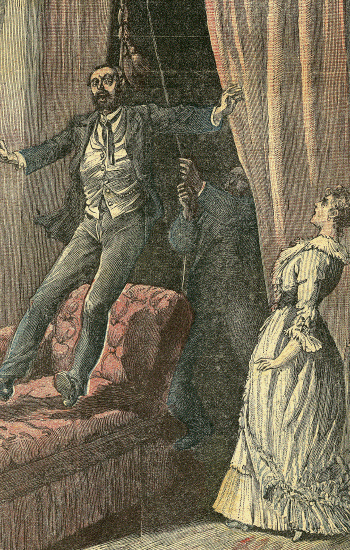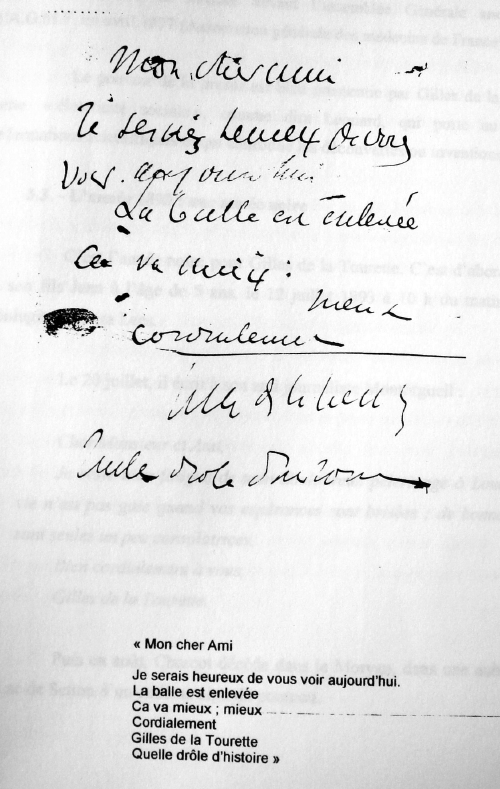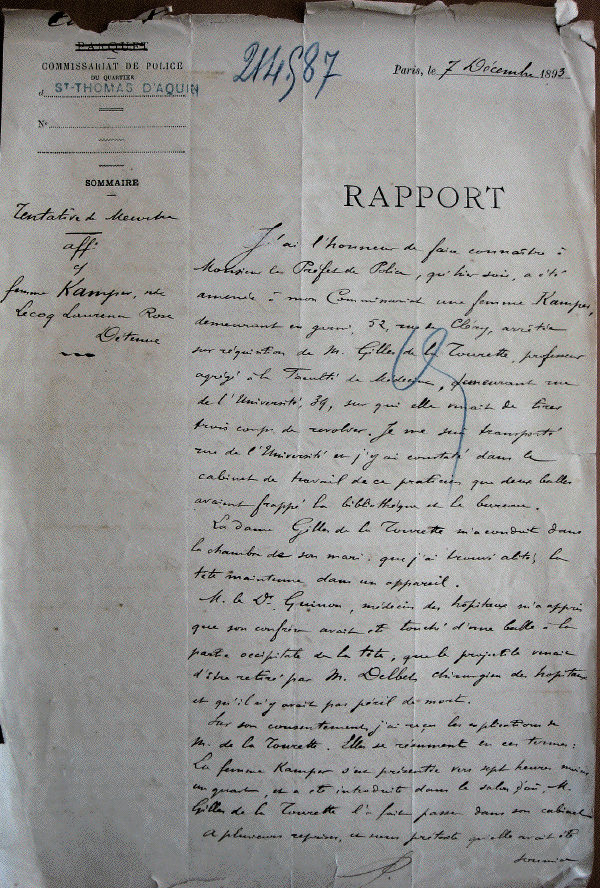- Gilles de la Tourette is known for the
disease which now bears his name, but his
activities in the management of hysterics and in
hypnotism, which gained him most of his lifetime
reputation, are now largely forgotten. As one of
the closest followers of Jean-Martin Charcot, he
always remained faithful to his mentor's views,
and was one of the most vehement defenders of La
Salpêtrière school during the
quarrel with the Nancy school. This was critical
during medico-legal controversies on the issue
of crimes committed under hypnotic suggestion.
His involvement in criminal hypnotism was
striking, as shown by his own experiments, the
most famous of which is his suggested poisoning
of a colleague by Blanche Wittman, the
celebrated Charcot's hysteric patient. He also
acted as expert in murder trials, and his
Épilogue in the Gouffé's trunk
case, where he affirmed that no murder in real
life could be due to hypnotism, and considered
that Gabrielle Bompard, the murderer's
accomplice, was not under hypnotic suggestion,
had a considerable impact. Finally, he was
confronted to the issue of murder under
hypnotism in his private life, since in 1893, a
former patient, Rose Kamper, came and shot him
in his home, claiming that hypnotism sessions
had changed her own person, and also that she
had been hypnotized "at distance". These events
highlight the Salpêtrière's
theories on hypnotism and their inner
contradictions in the fin de siècle
ambiance, a few years before Joseph Babinski
renewed the concepts on hysteria.
-
- Charcot introduced hypnotism in the
management of hysterics around 1878, at a time
when esoteric practices using hypnosis were
gaining a considerable interest in the public
(). Georges Gilles de la Tourette (1857-1904),
who had started to work with Charcot in 1884,
became one of his closest disciples. He is best
remembered for his 1885 paper on the disease
which now bears his name (), but during his
lifetime, he was mainly known for his work on
hysteria and hypnotism, which he summarized
between 1887 and 1895 (). He developed
medico-legal interests (), which were critical
during the well-known dispute between the
Salpêtrière and Nancy schools, the
latter being mainly represented by Hippolyte
Bernheim and Jules Liégeois, who
contested that susceptibility to hypnotism was a
feature of hysteria (). They also sustained that
murders could be committed under hypnosis
(Liégeois had done experiments using fake
weapons), while La Salpêtrière
members claimed that rape was the only crime
associated with hypnosis (). Gilles de la
Tourette's involvement is well demonstrated in
the following stories of criminal hypnotism in
three famous women at the time.
-
- Blanche
Wittman: Gilles de la Tourette as
practitioner of criminal hypnotism
-
- In his 1887 book (), Gilles de la Tourette
reported (pp. 131-135) a striking experiment of
suggested murder under hypnosis in one of the
most famous hysterics of Charcot's circle,
Blanche Wittman (the woman fainting in
Babinski's arms during Charcot's teaching in the
1887 painting by Brouillet). Previous reports of
this experiment were inaccurate (), so that it
is useful to summarize it. Gilles de la Tourette
reported that in June, 1884 at La
Salpêtrière, he hypnotized Blanche
W… in front of colleagues and other people,
including the playwright Jules Claretie. Then,
he pursued a conversation with her, in which he
soon introduced the command: "When you will be
awake, you will poison Mr. G…". The
conversation continued: "But why do you want me
to poison Mr. G…? He has done nothing to
me, he is a very nice chap. &endash; I want you
to poison him. &endash; I will not poison him.
After all, I am not a criminal. &endash;
However, you know well that he is the cause of
your dispute with Mrs. R… - Come on!
&endash; For sure. &endash; I have no poison,
perhaps I could stab him with a knife or shoot
him with a gun? &endash; The gun is too noisy
(…) here is a glass, I am pouring some beer
and adding the poison, now you need to have Mr.
G… absorb it, when you will be awake.
Whatever happens, you will not remember, if
questioned, that this is me who told you to
poison Mr. G… (…) &endash; Alright,
sir". Then the patient was waken by a soft air
blow on the eyes. She said hello to the people,
chatting with Claretie, before going to Mr.
G…: "My God! How hot it is here, are you
not thirsty? I am dying of it, I am sure you
must be thirsty. Mr L…, don't you still
have any bottles of beer? Please, give us one",
and the conversation went on with Mr. G…:
"Not necessary, I can assure you, Miss, that I
am not thirsty. &endash; With this heat, this is
impossible, you cannot refuse, by the way Mr.
L… was kind enough to give us some beer a
moment ago, and here we are, this is a full
glass (she offered him the glass with the
fictive poison), please accept it from my own
hand, and drink. &endash; Thank you, but I am
not thirsty, however, I can agree to take it,
but not without a kiss". Gilles de la Tourette
mentioned that the patient firstly went
backwards, but since she "must" accomplish the
fatal order, she smiled, and would even have
given herself if necessary. She went on: "You
are demanding, but… (he kissed her). Now,
drink. Do you fear that there is anything bad in
this beer? See, I drink some it myself (she put
the glass to her lips, avoiding to take any
beer). You kissed me, I drank in your glass: we
are equal". Then, G… drank and fell on the
floor, while the patient muttered: "This is
done". After the body of Mr. G… was carried
in the next room, the "experiment" continued
with interrogations by an investigator. When
questioned if she knew that there was poison in
the glass, Blanche replied: "Sir, I can affirm
that there was none, and the proof is that Mr.
G… kissed me, and I had taken the liberty
to drink in his glass, but you can see that I am
perfectly alright". Gilles de la Tourette
emphasized that she had created a counter-proof,
and that it was impossible to obtain further
information. But since she was getting
hyperexcited, he put her asleep again, and told
her that the scene had never taken place, in
order to quieten her.
-
- Gilles de la Tourette also quoted another
hysteric, H. E…, who was told under
hypnosis that she should shoot an interne, about
whom she had been complaining for inefficient
treatment. After being put awake, she was given
a gun and shot the interne, subsequently
explaining that she had done it because his
treatment was poor. These "experiments" show the
contradictions of the Salpêtrière
school at the time of the quarrel with Bernheim
and Liégeois: the facts were presented in
a way highlighting that murders can be provoked
by hypnotic suggestion, even though only in
hysterics, while at the same time, it was
claimed that rape was the only crime associated
with hypnotism. Gilles de la Tourette contested
Liégeois experiments of hypnotic crimes
with weapons, but indeed his two cases are
identical. He claimed that such suggestions
could only be performed in a laboratory, with a
set up scenario. However, one does not
understand the reason why they could not also
take place in real life.
-
- Gabrielle Bompard: Gilles de la Tourette
as criminal hypnotism expert
-
- In 1889-1890, a criminal affair with a
famous trial captivated the public,
"Gouffé's trunk". The body of the bailiff
Gouffé had been found nearby Lyons on 13
August, 1889, and it was subsequently proven
that it had been carried from Paris (where he
had been killed on 26 July) in a huge trunk,
which had been bought in London. The murder was
particularly pervert, as Gouffé had been
set up by a young woman, Gabrielle Bompard, who
had invited him to her apartment and placed him
on a chaise longue, where she playfully put the
bell of her peignoir around his neck and
discretely attached it to a hanging system,
which had been installed by her accomplice
Michel Eyraud. He was hidden behind the couch
during the preliminaries between Gouffé
and Gabrielle, and suddenly pulled on the end
cord of the system, hanging the bailiff who died
within two minutes () (fig. 1). The murderers
found no money on Gouffé and at his
office, and they flew away after having
transported the corpse and left it nearby Lyons.
Gabrielle finally gave herself up on 22 January,
1890, and since that time, it was repeatedly
noted that she behaved like an unworried child,
with her jokes, coquettishness and childishness
being reported and commented upon in the press
(). When she was taken by train to the place
where Gouffé's body had been found, she
behaved like an actress, sending kisses to the
public in stations, and receiving flowers and
sweets. Eyraud was subsequently arrested, and
the trial took place on 16 December, 1890.
Gabrielle's lawyer based her defense on the fact
that she had been hypnotized by Eyraud, a
possibility which was reinforced by Jules
Voisins, who had had the opportunity to
hypnotize her, as a prison doctor. Bernheim also
supported that view, but because of a broken
leg, he was unable to attend the trial.
Liégeois replaced him, putting forward
his own experiments of crimes under suggestion.
However, he was ridiculed by the experts Paul
Brouardel and Gilbert Ballet, who re-emphasized
the Salpêtrière doctrine that no
murder under hypnosis did exist, concluding that
Gabrielle was not ill, but had an incomplete
development of moral sense contrasting with good
intellect (). The trial also somewhat inverted
the roles in underlining the seducing,
"hypnotizing", power of certain women on men.
Eyraud was sentenced to death, and Gabrielle got
twenty years to jail. On that occasion, Gilles
de la Tourette wrote a famous, "definitive",
Épilogue () destroying the Nancy school,
and proclaiming the victory of Charcot's
theories. However, this victory may have had a
bitter taste, since the Salpêtrière
school was also damaged, as he said three years
later in an interview for L'Éclair (21
August, 1893) : "I remember that after the
spectacular trial, in which Gabrielle Bompard
was the heroin, my poor master told me: 'this is
now done for ten years with hypnotism. We will
have to leave it for a long time to those who
have now put their hand on it' ".
-
 -
- Rose Kamper: Gilles de la Tourette as a
victim of hypnotism
-
- On 6 December, 1893, at 18:45, at Gilles de
la Tourette's domicile, 39 rue de
l'Université, a young woman asked for
him, and since he was not back from the
hospital, she said she would wait for him. When
he arrived fifteen minutes later, she
immediately followed him and told that she had
been hypnotized many times, being now without
resources and asking for 50 francs. He vaguely
remembered to have seen her (and indeed she had
participated to several hypnotism sessions), and
told her to give her name and address. Since she
asked for money again, he went to the door, when
he heard a shot and felt a violent shock in the
back of the head (fig. 2). Two new shots
followed, but he could leave the room, feeling
blood pouring down to his neck. This story
shortly was reported in Le Progrès
Médical by Georges Guinon, who arrived a
few minutes later, and saw the woman quietly
sitting in the waiting room, apparently
satisfied (). Guinon's article was published
with the purpose to stop the already spreading
rumors of an assault perpetrated under hypnosis
(). The wound was not severe, and the same
evening, Gilles de la Tourette was able to write
to his friend the journalist Montorgueil: "What
a strange story" (). Previous mentions of the
event inaccurately reported that it led to a
famous trial (), while there was no trial at
all. The woman, named Rose Kamper (born Lecoq,
on 23 June, 1864, in Poissy) indeed was
recognized to be insane. She had already spent
time at the Sainte-Anne asylum, and was known to
have written threatening letters to the
administrator of the École Polytechnique
Mr. Rochas. She later told that she suspected
Gilles de la Tourette to be in love with her,
but also that she had been hypnotized without
her consent, with the consequence that her will
had been annihilated. She reported that she had
been hypnotized "at distance", and that there
was another person in her, who had pushed her to
shoot. She was examined by Brouardel, Ballet and
Jules Falret, who concluded to what nowadays
corresponds to paranoid schizophrenia, so that
she was sent back to Sainte-Anne and other
hospitals, from which she was intermittently
released. Interestingly enough, a couple of days
before the assassination attempt, Gilles de la
Tourette and Montorgueil had published an
article in L'Éclair on hypnotism
contesting the Nancy school. It is not
impossible that this had been a trigger for Rose
Kamper's act.
-
 -
- Gilles de la Tourette never changed his mind
on the hysteric nature of susceptibilty to
hypnotism, and in an 1897 letter to Montorgueil,
he was still opposing Bernheim. In 1900, the
first signs of general paresis developed, and he
died in 1904. Contrary to another famous pupil
of Charcot, Joseph Babinski, who spectacularly
distanced himself from his mentor's views , we
do not know whether he would also have modified
his opinion on hysteria and hypnotism.
 -
- La
maladie de Gilles de la Tourette
- La
maladie des tics convulsifs Gilles de la
Tourette G.(pdf)
- Contribution
à l'étude des bâillements
hystériques Nouvelle Iconographie de La
Salpêtrière1890
- Traité
clinique et thérapeutique de
l'hystérie d'après l'enseignement
de La Salpêtrière1895
- Gilles
de la Tourette par P. Legendre pdf
- Attentat
contre Gilles de la Tourette 07/12/1893
- La
nécrologie La Presse Médicale 4
juin 1904
- La
nécrologie Nouvelle Iconographie de la
Salpêtrière 1904
- The forgotten
face of Gilles de la Tourette: practitioner,
expert, and victim of criminal hypnotism at the
Belle Époque Bogousslavsky J
Walusinski O
- Criminal
hypnotism at the Belle Époque : The path
traced by Jean-Martin Charcot and Georges Gilles
de la Tourette Bogousslavsky J Walusinski O
Veyrunes D
- Correspondance
inédite de G. Gilles de la Tourette, sa
maladie fatale Walusinski O. Duncan G
- Correspondance
inédite de G. Gilles de la Tourette avec
JM. Charcot et G. Montorgueil Walusinski O.
Duncan G
- Vivre ses
écrits, l'exemple de G. Gilles de la
Tourette Walusinski O. Duncan G
- G.
Gilles de la Tourette 1857-1904 in
english
- L'état
mental de Froufrou G. Gilles de la Tourette
1892
- Mademoiselle
Bottard. Gilles de la Tourette G. La Revue
Hebdomadaire 1898
- Marguerite
Bottard (1822-1906) sa biographie et la lettre
inédite de G. Gilles de la Tourette
Walusinski O. PDF
-

|




